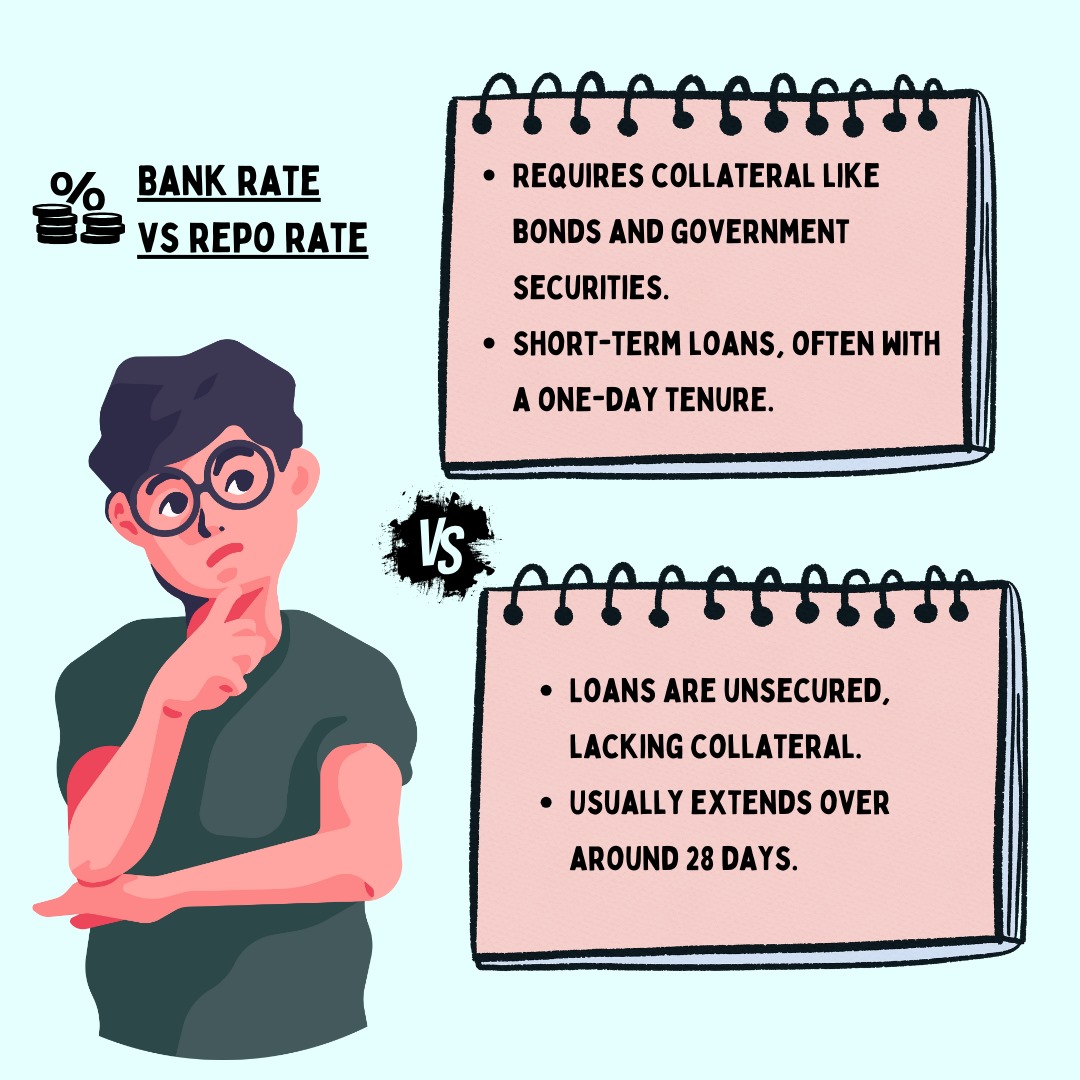Bank Rate Vs Repo Rate: What’s the Difference?

Have you ever found yourself pondering the intricacies of finance? In the dynamic landscape of financial markets, the terms Repo Rate and Bank Rate frequently take the spotlight.
As the Reserve Bank of India (RBI) strategically adjusts these rates to address economic challenges, delving into the nuances that set them apart becomes essential.
Here, we’re going to take a deep look into Bank Rate Vs Repo Rate: what’s the difference?
What is Repo Rate?
Picture this: you’re in a financial pinch, seeking a loan from your bank. Similarly, when banks find themselves short on funds, they turn to the central bank for assistance.
Enter the Repo Rate, the rate at which the RBI extends a financial lifeline to commercial banks during times of need (click here to find more on key financial rates).
In simpler terms, commercial banks borrow money from the RBI by selling securities or bonds, with an agreement to repurchase them at a predetermined price on a specified date. The interest charged on this borrowed cash is what we know as the Repo Rate.
This rate doesn’t merely exist in isolation; it wields influence over the liquidity rate in the banking system. If the RBI aims to bolster liquidity, it may lower the Repo Rate, encouraging banks to sell their securities.
Conversely, to rein in liquidity, the central bank might raise the interest rate, discouraging banks from borrowing easily.
Now, the Repo Rate dance isn’t a solo act. An increased Repo Rate means the central bank earns a higher interest rate from commercial banks.
On the flip side, an elevated Reverse Repo Rate signals that commercial banks are earning higher interest from the central bank when they deposit excess funds.
What is Bank Rate?
On the other side of the financial spectrum is the Bank Rate, the interest charged by the central bank on loans extended to commercial banks and other financial institutions.
Unlike the Repo Rate, there’s no repurchasing agreement, no securities changing hands, and no collateral involved in this transaction.
With the Bank Rate, commercial banks borrow funds from the central bank and then lend that money to customers at a higher interest rate, thereby turning a profit. This rate, often referred to as the “Discount Rate,” is a significant tool for controlling liquidity.
When the RBI decides to flex its monetary muscles by increasing the Bank Rate, it drives up the borrowing funds for banks. The result? A reduction in the money supply in the market.
Bank Rate Vs Repo Rate: What’s the Difference?
While Repo Rate and Bank Rate may look like financial siblings, they have distinctive characteristics:
- Nature of Transactions:
– Repo Rate: Involves repurchasing securities previously sold to the central bank.
– Bank Rate: Straightforward lending rate without collateral or repurchasing agreements.
- Collateral Involvement:
– Repo Rate: Securities, bonds, agreements, and collateral are part of the deal.
– Bank Rate: No collateral required; it’s a straightforward lending affair.
- Rate Hierarchy:
– Repo Rate: Typically lower than the Bank Rate.
– Bank Rate: Generally higher, reflecting its role in controlling liquidity.
- Direct Impact on Customers:
– Repo Rate: Changes are managed by banks and don’t directly affect customers.
– Bank Rate: Directly affects lending rates, influencing people’s ability to secure loans and impacting economic growth.
- Financial Focus:
– Repo Rate: Addresses short-term financial needs.
– Bank Rate: Catering to long-term financial requirements of commercial banks.
What is the Current Bank Rate Vs Repo Rate?
As of the latest update on February 8, 2023, the Repo Rate stands at 6.50%, while the Bank Rate is slightly higher at 6.75%.
The RBI’s strategy in adjusting these rates involves a delicate balance between stimulating economic activity and curbing inflationary pressures.
It’s important to note that any reduction in the Bank Rate Vs Repo Rate can potentially translate to lower interest rates for borrowers. Conversely, an increase in these rates would correspondingly raise the interest rates on loans.
What is the Importance of Bank Rate Vs Repo Rate?
Monitoring the repo rate movements over the past months provides a glimpse into the RBI’s proactive approach in steering the economic ship.
The 25-basis-point increase on February 8, 2023, follows a series of adjustments, including a 50-basis-point hike on December 7, 2022, and a 40-basis-point increase in an emergency meeting on June 9, 2022.
Each decision reflects the delicate dance between supporting economic growth and taming inflation, a balancing act the central bank must perform with precision.
Bank Rate Vs Repo Rate may share common ground as tools in the central bank’s toolkit, but their roles and impacts diverge significantly. The Repo Rate, with its focus on short-term liquidity needs, contrasts with the broader, long-term financial implications of the Bank Rate.
In conclusion, understanding Bank Rate Vs Repo Rate isn’t merely a matter of financial literacy; it’s a key to deciphering the intricate dance of monetary policy and its ripple effects on the broader economy.
As the Repo Rate and Bank Rate continue to shape the financial landscape, staying informed becomes more than a choice—it’s a financial necessity.









